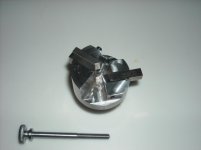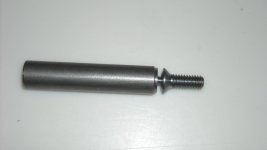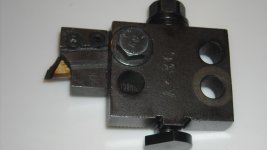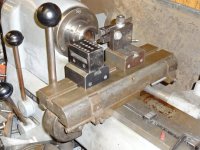I bought a Hardinge ESM-59 last week, and will be picking it up next weekend. I bought it without being able to inspect or run it, but the price was low enough that I'm viewing it as a learning experience for buying the next one if it turns out to be a real dog.

I'm a one man shop, and make a few products that I sell. My runs are usually around 100-200 pieces at a time, so I think a turret lathe will be a nice change from the 9" South Bend that I currently use for everything. As a quick first question, can I expect the Hardinge to be a little bit more rigid than the South Bend, or are they comparable in that respect?
My main questions are about tooling. Other than maybe some 5C collets, it doesn't come with much more than what is shown in the picture above. I did buy a Hardinge TT tapping head with some collets on eBay, and am trying to decide what I need next. I have never run a turret lathe before; I've watched what videos I could find, and read what I can, but there are huge empty spaces on the tiny canvas that is my knowledge. I'll ask a couple of questions today to get started.
One of the parts I make is a bolt. It's a simple one, made from brass or bronze round stock. The starting diameter ranges from 7/16" to 3/4". The shank is about 1" long, with about 3/4" of 8-32 thread (I already have a Geometric die head for that step).
For cutting the shank, I've found a few different options, but have no idea if there is one that is clearly best for this purpose. The first is a hollow mill (the one that looks like an annular cutter). The second is an adjustable hollow mill such as a Kutmore. The last choice I've found is a box cutter. Would I be able to set the rollers to follow the 0.170" diameter shank and use that setup for all of the bolts, or would I need to set it to the starting diameter? If the latter, should I get a box cutter for each starting diameter and leave it set for that size, or are the rollers easy to adjust to the different starting diameters?
Does anyone have multiple turrets that they use on the same lathe? All of the parts I make are recurring on a regular basis, and I have thought of picking up extra turret assemblies and leaving them set up for certain parts. Is that reasonable, or is swapping turrets out more involved than I am imagining and not worth doing? Alternatively, what about just buying extra hex turrets? Those would take up less storage space and they'd be easier to move around. Is it simply a matter of unbolting one hex turret and replacing it with another, or is there fitting and adjustment involved that makes this unpractical?
I'll stop here for now. Take it easy on this newbie, but please let me know if there is more information that I could provide to get a better answer. Thanks for your time!
Isaac

I'm a one man shop, and make a few products that I sell. My runs are usually around 100-200 pieces at a time, so I think a turret lathe will be a nice change from the 9" South Bend that I currently use for everything. As a quick first question, can I expect the Hardinge to be a little bit more rigid than the South Bend, or are they comparable in that respect?
My main questions are about tooling. Other than maybe some 5C collets, it doesn't come with much more than what is shown in the picture above. I did buy a Hardinge TT tapping head with some collets on eBay, and am trying to decide what I need next. I have never run a turret lathe before; I've watched what videos I could find, and read what I can, but there are huge empty spaces on the tiny canvas that is my knowledge. I'll ask a couple of questions today to get started.
One of the parts I make is a bolt. It's a simple one, made from brass or bronze round stock. The starting diameter ranges from 7/16" to 3/4". The shank is about 1" long, with about 3/4" of 8-32 thread (I already have a Geometric die head for that step).
For cutting the shank, I've found a few different options, but have no idea if there is one that is clearly best for this purpose. The first is a hollow mill (the one that looks like an annular cutter). The second is an adjustable hollow mill such as a Kutmore. The last choice I've found is a box cutter. Would I be able to set the rollers to follow the 0.170" diameter shank and use that setup for all of the bolts, or would I need to set it to the starting diameter? If the latter, should I get a box cutter for each starting diameter and leave it set for that size, or are the rollers easy to adjust to the different starting diameters?
Does anyone have multiple turrets that they use on the same lathe? All of the parts I make are recurring on a regular basis, and I have thought of picking up extra turret assemblies and leaving them set up for certain parts. Is that reasonable, or is swapping turrets out more involved than I am imagining and not worth doing? Alternatively, what about just buying extra hex turrets? Those would take up less storage space and they'd be easier to move around. Is it simply a matter of unbolting one hex turret and replacing it with another, or is there fitting and adjustment involved that makes this unpractical?
I'll stop here for now. Take it easy on this newbie, but please let me know if there is more information that I could provide to get a better answer. Thanks for your time!
Isaac



























